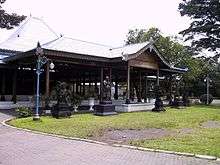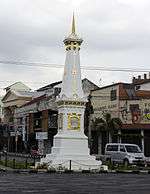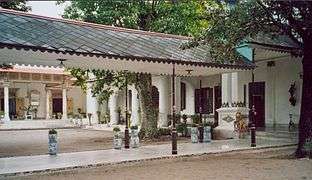Kraton Ngayogyakarta Hadiningrat
| Kraton Ngayogyakarta Hadiningrat (Keraton Jogja) | |
|---|---|
 Pagelaran hall of Yogyakarta Kraton | |
| General information | |
| Architectural style | Javanese Architecture |
| Location | Jl. Rotowijayan 1 55133, Yogyakarta |
| Construction started | 1755 |
| Client | Sultan of Yogyakarta |

Kraton of Yogyakarta (formally known as: Keraton Ngayogyakarta Hadiningrat) is a palace complex located in the city of Yogyakarta, Yogyakarta Special Region, Indonesia. The palace is the main seat Sultan of Yogyakarta and his family. It serves as a cultural center for the Javanese people and contains a museum that displays the sultanate's artifacts.
It is guarded by the His Majesty's Kraton Guard Regiment (Prajurit Keraton Ngayogyakarta Hadiningrat).
History
Yogyakarta Palace was built by Prince Mangkubumi in 1755-1756 (Javanese year: 1682),[1] several months after the signing of the Treaty of Giyanti between Prince Mangkubumi of Yogyakarta, Hamengkubuwono of Surakarta and Dutch East India Company. A Banyan Forest was chosen as the site of the palace due to its location between two rivers which were considered good protection from possible flooding.
On 20 June 1812, Stamford Raffles led a 1,200-strong British force to attack the walled royal city of Yogyakarta. The Javanese, although outnumbering the invader, weren't prepared for the attack and were taken back by the event. In one day the city of Yogyakarta fell and the royal palace was sacked and burned. The total loot from the palace valued £15,000 in gold, jewels and hard currency (which values £500,000 today). The event was the first time an attack has been carried out into a court in Java and as a result the sultanate was completely subjugated to colonial authority.[2]
Most of the palace's current form are built by Sultan Hamengkubuwono VIII who reign from 1921 to 1939. It suffered from an earthquake in 1876 and 2006, and was subsequently rebuilt after the devastation.[3]
Philosophy



Kraton means the place where the "ratu" (in English: Queen, in Javanese also mean: King) resides. The word "Keraton" (Keraton is living quarter of the royal family in the palace) (shortened form of ratu/Ka-ratuan) derived from the word "Ratu" which in Malay means king. The palace was built according to Javanese Philosophy and is shrouded by mysticism. The spatial arrangement of the palace, including the cityscape of the old city of Yogyakarta, including its architecture, direction of buildings, and objects all belongs to the mythological value and belief system of the Javanese. The main street of the old city forms a straight line from Tugu Yogyakarta, Kraton, Mount Merapi to Krapyak Hunting House. The layout mean "the origin of human beings and their last purposes" (Javanese: sangkan paraning dumadi).[1]
The road from Krapyak Hunting House to the palace symbolizes the first creation of men stage to adulthood. The villages surrounding Krapyak Hunting House are named "Mijen" from the word Wiji (seed). Along the way Tamarind and Spanish cherry trees are planted to represent the journey from childhood to adulthood. It then goes to Tugu Yogyakarta and finally ends at the palace, meaning the end of human life and meeting the Creator. And finally the seven gates of Gladhag to Donopratopo means the seven step to Heaven.[1]
Tugu Yogyakarta (Gilig golong monument) located on the north side of the old city is a symbol of "unification between the king (golong) and the people (gilig)" (Javanese: manunggaling kawulo gusti). It also symbolizes the final unity of the creator (Khalik) and His subjects. Gate Donopratoro (Gate to Kedaton quarter) means "a good person is someone who is generous and knows how to control his lust" and the two Dwarapala statues, named Balabuta and Cinkarabala, each represent good and evil. The palace's magical artifacts are believed to have the power to repulse evil intention.[1]
Cultural Performances
Yogyakarta Palace held cultural performances everyday:
- Gamelan - held every Monday-Tuesday at 10 AM
- Golek Menak puppet performance - held every Wednesday at 10 AM
- Dance Performance - Thursday at 10 AM
- Macapat - Friday at 9 AM
- Wayang Performance - Saturday at 9:30 AM
- Wayang Orang and dances performances - Sunday 9:30 AM
Popular Culture
The Kraton Ngayogyakarta Hadiningrat was served as the second pit stop in The Amazing Race 19.
Gallery
See also
References
- 1 2 3 4 OBYEK PENELITIAN, http://elib.unikom.ac.id/
- ↑ When Raffles ran Java, Tim Hanningan, historytoday.com
- ↑ Kraton, yogyes.com
Further reading
- Brongtodiningrat, K. P. H. (1975), The Royal Palace (Karaton) of Yogyakarta: Its Architecture and Its Meaning, Yogyakarta: Karaton Museum Yogyakarta, OCLC 12847099.
- Dwiyanto, Djoko (2009), Kraton Yogyakarta: Sejarah, Nasionalisme & Teladan Perjuangan (in Indonesian), Yogyakarta: Paradigma Indonesia, ISBN 978-979-17834-0-8.
External links
![]() Media related to Kraton of Yogyakarta at Wikimedia Commons
Media related to Kraton of Yogyakarta at Wikimedia Commons
- Kraton Yogyakarta Hadinigrat at Yogyakarta government official website (Indonesian)
- KratonJogja.com, created by Gadjah Mada University
- Kraton Yogya
Coordinates: 7°48′20″S 110°21′51″E / 7.805689°S 110.36406°E
